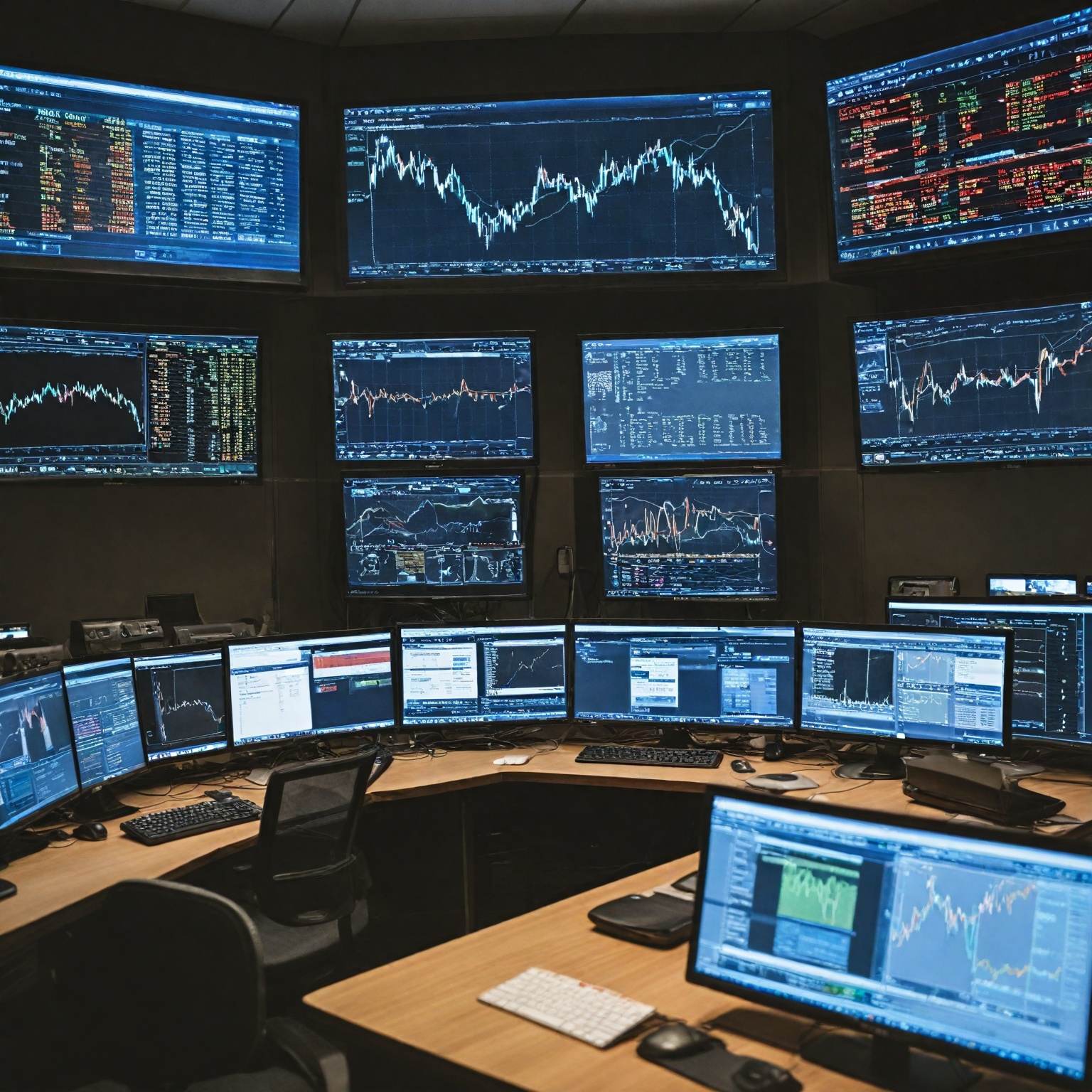Summary
**Stay Ahead of the Market Trends: Live Updates on S&P 500 Futures Movement** provides an in-depth overview of S&P 500 futures, a key financial instrument that enables investors to hedge or speculate on the future performance of the S&P 500 index, which tracks 500 large-cap U.S. companies. Since their introduction by the Chicago Mercantile Exchange (CME) in 1982, and the subsequent launch of the more accessible E-mini contracts in 1997, these futures have become essential tools for institutional and experienced individual traders due to their liquidity, leverage, and near 24-hour electronic trading.
S&P 500 futures serve as critical indicators of market sentiment and economic expectations, with prices influenced by a complex interplay of factors including macroeconomic data, geopolitical events, and technical market analysis. Traders rely heavily on real-time data feeds and sophisticated technical indicators such as the Relative Strength Index (RSI) and Moving Average Convergence Divergence (MACD) to make timely, informed decisions in a highly dynamic environment. The high liquidity and leverage inherent in these contracts allow market participants to efficiently manage risk or capitalize on short-term trends, albeit with the need for substantial expertise due to the instruments’ complexity.
Live updates on S&P 500 futures movements, enabled by advanced streaming technologies and continuous data dissemination, provide critical transparency and market efficiency, supporting rapid response to market developments. This real-time information flow is governed by regulatory frameworks distinct from those overseeing securities markets, with oversight from bodies such as the Commodity Futures Trading Commission (CFTC) ensuring timely reporting and market integrity. These frameworks balance the need for open access with market stability, although debates persist regarding data pricing and equitable distribution in futures markets.
Looking ahead, the integration of artificial intelligence, enhanced technical analysis tools, and real-time data platforms is poised to further transform S&P 500 futures trading, offering investors more precise forecasting and adaptive trading strategies. As these technologies evolve, they promise to deepen market insights and improve the ability of traders to stay ahead of shifting market trends while navigating the inherent risks of leveraged futures contracts.
Overview of S&P 500 Futures
S&P 500 Futures are financial contracts that allow investors to hedge or speculate on the future value of the S&P 500 Index, a leading market benchmark representing the performance of 500 large companies listed on U.S. stock exchanges. These futures were first introduced by the Chicago Mercantile Exchange (CME) in 1982, with the addition of the e-mini option in 1997 to provide more accessible trading sizes for investors.
Traded electronically on regulated exchanges, S&P 500 futures contracts represent a legally binding agreement between a buyer and a seller to purchase or sell the index at a predetermined price on a future date. They offer immediate exposure to the index’s movements while benefiting from the liquidity and transparency provided by the CME Group. Each standard futures contract has a multiplier of $250 per index point, meaning that if the S&P 500 is trading at 2,000, the contract’s nominal value would be $500,000.
In addition to standard contracts, there are also E-mini and micro E-mini contracts available, which cater to varying investment sizes and strategies. The E-mini S&P 500 futures are particularly notable for their high liquidity, trading at approximately eight times the daily value of all combined S&P 500 exchange-traded funds (ETFs) such as SPY, IVV, and VOO. This liquidity makes S&P 500 futures an attractive instrument for both institutional and experienced individual investors seeking to manage risk or capitalize on market trends efficiently.
Because futures are complex financial instruments, they require a solid understanding of market dynamics and risks. Their regulated trading environment ensures transparency and fairness, but they remain best suited for investors with sufficient expertise to incorporate them prudently into their portfolios.
Historical Context and Market Influences
S&P 500 futures provide investors with the ability to gain immediate exposure to the S&P 500 index through a regulated exchange environment, enhancing transparency and market efficiency. They serve as important indicators for market movements, as investors and financial media closely monitor changes in futures prices to gauge investor sentiment and anticipate potential shifts in the equity markets.
Market influences on S&P 500 futures prices are multifaceted, involving a range of economic, geopolitical, and technical factors. Economic indicators such as inflation, employment rates, interest rates, and consumer confidence significantly affect investor expectations and demand for equities, thereby impacting futures pricing. For example, a high employment rate typically increases consumer spending, which can positively influence corporate earnings prospects and equity valuations.
Geopolitical risks also play a critical role in shaping market dynamics. Events such as wars, terrorism, political polarization, and elections introduce uncertainty that can lead to increased market volatility and affect futures prices. The geopolitical risk index (GPR), which measures the frequency of adverse geopolitical events reported in leading newspapers, has been used to quantify such risks and their economic repercussions. Additionally, emerging risks like cyberattacks on critical infrastructure and climate-related threats are increasingly recognized as influential factors on global market stability and investor confidence.
Technical analysis further contributes to understanding S&P 500 futures movements. Traders often rely on historical price data and technical indicators such as the Relative Strength Index (RSI), Moving Average Convergence Divergence (MACD), and Bollinger Bands® to predict short-term price trends and inform trading decisions. These techniques complement fundamental analysis by focusing on market sentiment and momentum, particularly in the highly liquid futures markets.
Moreover, real-time economic calendars, such as those provided by FXStreet, are crucial tools for investors to track scheduled economic data releases from the United States, the largest global economy. Such data releases often cause immediate reactions in futures prices due to their impact on the valuation of the U.S. dollar and expectations for economic growth.
Technical Analysis of S&P 500 Futures
Technical analysis of S&P 500 futures involves using historical price, volume, and open interest data to forecast future price movements and identify potential trading opportunities. Traders employ various technical indicators that can be broadly categorized into overlays and oscillators to analyze market conditions and determine optimal entry and exit points.
Common technical indicators applied to S&P 500 futures include the Relative Strength Index (RSI), Money Flow Index (MFI), stochastics, Moving Average Convergence Divergence (MACD), and Bollinger Bands®. These tools help traders gauge momentum, overbought or oversold conditions, trend strength, and volatility. For instance, moving averages are often used as filters; a typical example is when the 10-day moving average is above the 30-day moving average and the closing price is above the 200-day moving average, signaling a potential long trade setup.
Additionally, volume-based indicators like the Relative Vigor Index (RVI) and volume moving averages provide insights into the intensity of recent price actions and help confirm trend persistence. Techniques such as Fibonacci retracement and extension levels across multiple timeframes also contribute to identifying confluence zones that can strengthen trade signals and improve decision-making accuracy.
By combining two to four complementary indicators rather than relying on a single signal, traders can better filter out false signals and enhance their ability to stay ahead of market trends in the highly liquid and leveraged S&P 500 futures market. This approach is especially valuable given the nearly 24-hour access to trading, enabling participants to react promptly to off-hour news and events impacting the index.
Real-Time Data and Live Updates
Real-time data plays a crucial role in providing live updates on the S&P 500 futures movement, enabling traders and investors to make informed decisions based on the most current market conditions. Real-time data platforms utilize advanced technologies such as streaming data platforms, real-time databases, and low-latency API layers to process and disseminate vast amounts of information instantly from multiple concurrent sources. These platforms can handle millions of events per second, often integrating with streaming services like Kafka to ensure seamless data ingestion and publication.
Unlike traditional messaging or database systems that require manual refreshes or operate on static data, real-time messaging systems continuously update workloads to reflect the latest information. This distinction is essential for financial markets where price and transaction data change rapidly, necessitating immediate access to the newest data streams. For S&P 500 futures, live data feeds provided by sources such as the CME Group enable traders to monitor market movements as they happen, supporting hedging and speculative strategies.
The live updates include pricing, volume, and other transaction details that are vital for efficient market functioning. However, the regulatory treatment of such data differs between securities and futures markets, with futures data often governed under different frameworks than stock quotations and transaction prices. To enhance user experience, many platforms combine these live feeds with expert analysis and technical indicators, helping traders interpret market trends and identify potential trade opportunities in real time.
Regulatory Framework Governing Futures Data Dissemination
The regulatory framework overseeing the dissemination of futures market data differs significantly from that governing securities markets. In securities trading, stock quotations and transaction prices are treated as a common-pool resource jointly managed by self-regulatory organizations (SROs), with centralized control over data dissemination and pricing to ensure market transparency and fairness. By contrast, the futures market operates under a market-based framework where data reporting and dissemination mechanisms have evolved separately, providing an alternative model for regulatory consideration.
The Commodity Futures Trading Commission (CFTC) plays a central role in regulating futures market data reporting. It mandates timely public reporting of swap transaction and pricing data through rules that cover real-time reporting, recordkeeping, and block trade definitions, with ongoing amendments to reflect market changes. The CFTC’s weekly Commitments of Traders (COT) reports offer detailed breakdowns of speculative positioning in U.S. futures markets, ensuring transparency about market participants’ net positions and aiding in market analysis.
Moreover, regulatory efforts have been directed at modernizing the infrastructure of the national market system, as exemplified by amendments under Regulation National Market System (Regulation NMS). These amendments seek to enhance the content and dissemination methods of market data, including the integration of odd-lot quotes and other data subsets, to maintain timely, comprehensive, and reliable market information. While such amendments primarily focus on equities, they influence the broader regulatory environment affecting futures data standards.
Futures data dissemination is also influenced by the operational practices of major exchanges such as the Chicago Mercantile Exchange (CME), which provides nearly 24-hour electronic trading on platforms like CME Globex and streams live futures and options market data directly to market participants. This continuous, real-time data availability aligns with regulatory objectives of ensuring market efficiency and transparency.
Influence on Investors and Traders
S&P 500 futures play a significant role in shaping the decisions of investors and traders by providing a regulated, liquid, and accessible means to speculate on or hedge against the future value of the S&P 500 index. Because these futures contracts reflect anticipated market movements, they are closely followed by both the financial media and market participants as key indicators of overall market sentiment and direction.
The E-mini S&P 500 futures contract, traded on the Chicago Mercantile Exchange under the ticker symbol ES, offers traders substantial leverage—up to 60 times the buying power of cash stocks—allowing them to control a large value of assets with relatively low capital outlay. This leverage, combined with nearly 24-hour market access, enables traders to respond swiftly to off-hour news and events that might affect market conditions.
Moreover, futures trading facilitates strategies such as short selling without the restrictions found in equity markets (e.g., no uptick rule), making it easier to take advantage of downward price movements. Spread trading, such as trading the S&P 500 futures against other sectors like small caps, also demands less time, capital, and number of trades compared to stock trading, increasing operational efficiency for active traders.
Investors and traders often employ technical indicators alongside S&P 500 futures data to refine their market analysis and improve trade selection. Combining multiple complementary technical indicators helps them identify potential trades more reliably rather than relying on a single signal. For example, moving average filters that compare short-term and long-term trends can guide traders on whether to consider long or short positions based on prevailing market momentum.
In addition, forex and futures signal services provide traders with trade ideas including entry points, stop-loss, and take-profit levels, which can be directly applied to futures trading strategies, further influencing decision-making processes. The availability of sophisticated trading platforms that integrate futures, options, and block markets data enables traders to act quickly and securely, capitalizing on market trends as they develop in real time.
Related Financial Instruments and Comparative Analysis
S&P 500 futures are a prominent financial instrument traded on the Chicago Mercantile Exchange (CME) that allow investors to speculate on or hedge against movements in the S&P 500 index, a capitalization-weighted index representing 500 of the largest U.S. companies. These futures contracts are cash-settled and available in various sizes, including E-mini and micro E-mini contracts, which trade electronically and offer accessibility to a broad range of market participants.
E-mini S&P 500 futures, in particular, provide significant advantages due to their deep liquidity and tight bid-ask spreads, making them one of the most cost-effective ways to gain market exposure to the S&P 500 Index. These contracts offer around-the-clock trading opportunities and exhibit daily liquidity that surpasses the combined value of all S&P 500 exchange-traded funds (ETFs) such as SPY, IVV, and VOO by approximately eight times. This liquidity enhances the efficiency of trade execution and reduces transaction costs for active traders.
Compared to ETFs and other equity-based instruments, futures contracts deliver the benefits of regulated exchange trading and leverage, allowing traders to take larger positions with relatively smaller capital outlays. However, futures are complex instruments best suited for experienced investors due to their inherent risks and margin requirements. Additionally, futures facilitate direct investment in the index without the need to purchase individual stocks, enabling efficient portfolio diversification and tactical positioning in response to market trends.
Technical analysts often incorporate data from S&P 500 futures into their trading strategies, using various technical indicators such as the Relative Strength Index (RSI), Moving Average Convergence Divergence (MACD), and Bollinger Bands to predict future price movements based on historical price and volume data rather than fundamental factors. Combining multiple complementary technical indicators improves the reliability of trading signals, allowing traders to better capitalize on short-term price fluctuations prevalent in futures markets.
Moreover, trading platforms provided by CME Group offer integrated access to futures, options, and block markets through fast and secure interfaces, supporting sophisticated market participants with comprehensive tools for analysis and execution. Expert commentary and economic analysis further assist traders in understanding underlying market trends and opportunities within the futures and options landscape.
Future Trends and Developments
The future of S&P 500 futures trading is increasingly shaped by advancements in data analysis, technology, and trend-following methodologies. One notable development is the growing reliance on AI-powered research tools and trend reports, which provide traders with faster and more accurate insights to identify emerging market opportunities. These technologies enable market participants to stay ahead by uncovering major shifts in market dynamics before they become widely recognized.
Trend-following strategies remain fundamental in futures trading, particularly when used as filters to focus capital allocation on the most promising market segments. By objectively designating the current market trend—whether up, down, or trendless—these indicators help maximize returns and minimize exposure to unfavorable conditions. The integration of sophisticated technical indicators, such as the Relative Strength Index (RSI), Moving Average Convergence Divergence (MACD), and Bollinger Bands®, continues to refine the predictive power of market analyses.
Real-time data platforms and continuous expert analyses also play a critical role in enhancing the responsiveness of traders to market movements. Access to actionable forex trading signals and live chart updates allow traders to react promptly to key chart patterns and price levels, increasing the efficiency of trade execution. Moreover, regulatory frameworks governing market data dissemination ensure that transaction and price information remain transparent and fairly accessible, which supports the integrity and functioning of the futures markets.
As these trends evolve, the

























